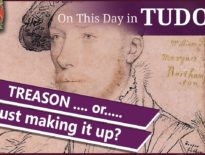On this day in Tudor history, 21st October 1536, during the Pilgrimage of Grace rebellion, Lancaster Herald had an encounter with armed peasants on his way to Pontefract Castle and then met with rebel leader, Robert Aske, at the castle. The meeting didn't go well, with Aske putting his foot down and not allowing the herald to complete his mission.
What was going on? Who was Lancaster Herald? What was his mission?
Find out more about the situation at Pontefract in today's talk.
Also on this day in Tudor history, 21st October 1532, King Henry VIII left his sweetheart, Anne Boleyn, behind in Calais while he travelled to Boulogne to spend a few days at the French court with Francis I. They had a bit of a bromance really, with Henry calling Francis his "beloved brother" and Francis instructing his sons to be "loving always" to Henry. However, Anne Boleyn was disappointed with the situation and you can find out more about what was going on in last year’s video:
Also on this day in history:
- 1449 – Birth of George, Duke of Clarence, son of Richard, Duke of York, and brother of Edward IV and Richard III, at Dublin. He was born in Ireland because his father was serving there as Lord Lieutenant of Ireland. Clarence was also the father of Margaret Pole, Countess of Salisbury.
- 1542 – “The 21st day of October in the xxxiiij year of the reign of our Sovereign lord King Henry the viijth., the duke of Norfolk’s grace, lieutenant to the King’s Highness, removed and camped in the borders of Barwicke”. Records show that Norfolk and his men went on to burn and pillage a number of towns in the Scottish borderlands.
- 1554 – Death of John Dudley, 2nd Earl of Warwick and son of John Dudley, Duke of Northumberland, at Penshurst, the house of his brother-in-law Henry Sidney, in Kent. Dudley and his brothers, Robert and Henry, had just been released from the Tower of London after the fall of their father, brother Guildford and sister-in-law, Lady Jane Grey.
Transcript:
On this day in Tudor history, 21st October 1536, during the Pilgrimage of Grace rebellion, Lancaster Herald, on nearing Pontefract Castle, encountered a group of armed peasants. The peasants explained that they were armed “to prevent the ‘comontte’ and Church being destroyed; for, they said no man should bury, christen, wed, or have beasts unmarked without paying a tax and forfeiting the beast unmarked to the King’s use.”
Now before I tell you what happened next, I’ll explain who Lancaster Herald was and also what was going on during the rebellion at this time. The Lancaster Herald, or Lancaster Herald of Arms in Ordinary, to give it its full title, was and is an officer of arms of London’s College of Arms. An officer of arms’ duties included conserving heraldic and genealogical records, arranging and participating in ceremonies of state, such as coronations, and controlling armorial matters, i.e. issues to do with coats of arms. But heralds would also read out royal proclamations, and this is what Thomas Milner, Lancaster Herald, had been sent to the rebels to do.
As I’ve explained in previous talks on the 1536 rebellion, the Pilgrimage of Grace rebellion was an uprising in the North, mainly in Lincolnshire and Yorkshire, which began in early October 1536. The rebels grievances included the dissolution of religious houses, the rise of men like Thomas Cromwell and Richard Rich and their influence on the king and his government, and the promotion of churchmen who they saw as subverting the faith of Christ. By this day in 1536, the uprising had spread from Lincolnshire into the East Riding, West Riding and North Riding of Yorkshire, and the previous day, Pontefract Castle had yielded to the rebels and its inhabitants, which included its owner Baron Darcy, and Edmund Lee, Archbishop of York, among others, had signed the rebel oath. However, the Lincolnshire rebels had dispersed on 11th October after the king had threatened them with charges of treason if they didn’t.
Lancaster Herald had been sent to Pontefract to read out a proclamation telling of how the Lincolnshire rebels had submitted to the king. After his encounter with the armed peasants, the herald was able to continue on to Pontefract Castle, where he met with rebel leader lawyer Robert Aske. Aske refused to let the Herald read out the proclamation, declaring that he and his people were intent on staying true to their cause and would be marching on London “on pilgrimage to the King to have all vile blood put from his Council and noble blood set up again; to have the faith of Christ and God’s laws kept, and restitution for wrongs done to the Church, and the “comonte” used as they should be”.
Lancaster Herald asked for this in writing. According to the herald, Aske then “called for the oath he gave his people and said the articles were in it, and delivered it to me, offering to put his hand to it.” When the herald did ask him to put his hand to it, Aske “did so, saying with a proud voice “This is mine act who so ever say to the contrary.” Lancaster Herald reiterated that he was required to read his proclamation to the people, but Aske would not let him and instead offered him safe conduct out of the castle and town.
The rebellion came to an end when Aske dismissed his rebels in November 1536, after the king promised that their demands would be met and that they would all be pardoned. Unfortunately, the king went on to break these promises.




Today the rebels would demand
No lockdowns
Pubs open until midnight
Fans back in football stadia
Tories out
Pay rises of 20%
Job Retention at 100%